Cost Control Guide for Shenzhen Mall Development Project
- latest articles
- 1.DApp Development & Customization: Merging Diverse Market Needs with User Experience 2.Analysis of the Core Technical System in DApp Project Development 3.How to achieve cross-chain interoperability in Web3 projects? 4.How does the tokenization of points reconstruct the e-commerce ecosystem? 5.How to Set and Track Data Metrics for a Points Mall? 6.What is DApp Development? Core Concepts and Technical Analysis 7.Inventory of commonly used Web3 development tools and usage tips 8.Development of a Distribution System Integrated with Social E-commerce 9.Six Key Steps for Businesses to Build a Points Mall System 10.What is DApp Development? A Comprehensive Guide from Concept to Implementation
- Popular Articles
- 1.Future Trends and Technology Predictions for APP Development in 2025 2.Analysis of the DeFi Ecosystem: How Developers Can Participate in Decentralized Finance Innovation 3.From Zero to One: How PI Mall Revolutionizes the Traditional E-commerce Model 4.DAPP Development | Best Practices for Professional Customization and Rapid Launch 5.Recommended by the Web3 developer community: the most noteworthy forums and resources 6.How to Develop a Successful Douyin Mini Program: Technical Architecture and Best Practices 7.From Cloud Computing to Computing Power Leasing: Building a Flexible and Scalable Computing Resource Platform 8.Shared Bike System APP: The Convenient Choice in the Era of Smart Travel 9.How to Create a Successful Dating App: From Needs Analysis to User Experience Design 10.From Design to Development: The Complete Process of Bringing an APP Idea to Life
With the continuous advancement of China's urbanization process, Shenzhen, as a pioneering city in reform and opening-up, has experienced sustained and vigorous growth in its economic development and real estate market. Against this backdrop, shopping mall development projects in Shenzhen have become a crucial component of commercial real estate. However, these projects often involve substantial investments and complex management processes. How to reasonably control costs while ensuring project quality and timelines has become an urgent challenge for developers, investors, and project managers.
Cost control is one of the core tasks in project management, directly impacting the final profitability and market competitiveness of development projects. This article will explore how to ensure the successful completion of projects and achieve favorable economic returns in the market through effective cost control measures, starting from the different stages of Shenzhen's shopping mall development projects.
I. Overview of Shenzhen Shopping Mall Development Projects
Shopping mall development projects typically involve multiple stages, from site selection and planning to construction, investment attraction, and operations, involving numerous departments and personnel. As a high-density, high-value city, Shenzhen's shopping mall developments must not only meet commercial functions but also possess innovation and market appeal. Therefore, cost control requirements during the design, construction, and operational phases of Shenzhen's shopping mall projects are particularly stringent.
Cost control in shopping mall development generally includes land costs, construction costs, design costs, equipment procurement costs, investment attraction costs, and operational costs, among others. Controlling each cost component not only affects the project's total budget but also has a profound impact on its long-term profitability. Thus, cost control in Shenzhen's shopping mall development projects requires precise management at every stage, from overall planning and detailed execution to post-construction management.
II. Major Challenges in Cost Control for Shopping Mall Development Projects
1. High Land Costs
Shenzhen has limited land resources, and land prices continue to rise, with land costs typically accounting for a significant portion of the total development cost of shopping malls. Therefore, how to reasonably plan development on high-cost land has become the primary challenge in cost control. Developers must conduct scientific market research and adopt precise site selection strategies to choose land with the most potential and cost-effectiveness, thereby saving on land costs.
2. Complexity in the Design Phase
The design of shopping mall development projects must consider multiple factors, including functionality, aesthetics, safety, and sustainability. Due to the complexity of the design phase, high design costs often arise. If the design lacks foresight or requires extensive modifications, it can lead not only to project delays but also to additional expenses. Therefore, ensuring the rationality and stability of the design plan is key to cost control in shopping mall development projects.
3. Cost Fluctuations During Construction
During construction, factors such as raw material prices, labor costs, and construction techniques can lead to cost fluctuations. For example, changes in the prices of construction materials like steel and concrete can significantly impact the project's budget. Additionally, issues such as construction quality problems, delays in construction timelines, and equipment failures can increase the overall project costs. Therefore, cost control during the construction phase requires high flexibility and adaptability.
4. Post-Construction Operational Costs
After the shopping mall is completed, ongoing operational investments are required. Expenses for various services, including property management, security, cleaning, and facility maintenance, can all impact the project's profitability. Therefore, how to reduce unnecessary expenditures while ensuring operational quality is another major challenge in cost control.
III. Strategies for Cost Control in Shenzhen Shopping Mall Development Projects
1. Cost Control in Site Selection and Land Acquisition
Land is one of the most important cost components in shopping mall development projects. In high-priced cities like Shenzhen, reasonable site selection can effectively reduce land costs. Developers should select land with appreciation potential and relatively high cost-effectiveness based on factors such as market demand, regional development potential, and transportation convenience.
Additionally, by collaborating with the government to secure preferential policies in land auctions or through appropriate land use rights transfers and acquisitions, developers can achieve certain savings on land costs. For developers, land acquisition should not only consider current prices but also future appreciation potential, avoiding盲目 following trends in land purchases that could lead to unnecessary financial waste.
2. Design Optimization and Cost Control
The design phase is a critical环节 in shopping mall development projects, directly impacting subsequent construction and operational costs. During the design process, developers should optimize architectural plans based on market demand, avoiding overly luxurious or impractical designs. The design should be forward-looking, balancing functionality and aesthetics while emphasizing feasibility and economy.
To better control design costs, developers can establish long-term partnerships with design firms, negotiating reasonable design fees. Furthermore, once the design plan is finalized, the number of modifications should be strictly controlled to avoid additional costs resulting from design changes.
3. Cost Management During Construction
During the construction phase, effectively managing construction costs is a core task in shopping mall development projects. First, developers should select reputable construction units and sign detailed contracts that clearly define cost budgets, timeline requirements, and quality standards. Through strict construction management, ensure the project is completed on time, with quality and quantity, avoiding additional costs due to quality issues or construction delays.
Second, raw material procurement should be centralized as much as possible, utilizing long-term contracts or bulk purchasing to reduce material procurement costs. At the same time, developers should establish long-term partnerships with suppliers to secure price advantages during price fluctuations.
4. Risk Warning and Emergency Management
In shopping mall development projects, various risks are inevitable, such as material price fluctuations, labor shortages, and natural disasters. To address these risks, developers should establish robust risk warning mechanisms, using appropriate insurance, risk sharing, and emergency management measures to mitigate the impact of unexpected events on project costs.
Additionally, project managers should regularly conduct cost analyses, monitor cost fluctuations in real-time, and promptly adjust budgets and control measures to ensure the stability and rationality of the project budget.
5. Cost Control in the Post-Construction Operational Phase
After the shopping mall is completed, cost management during the operational phase is equally crucial. First, developers should合理安排 property management services to ensure精细化管理 of operational costs. In property management, daily operational expenses can be reduced through intelligent management手段 and energy-saving measures.
Furthermore, the mall's leasing management and investment attraction efforts directly affect the project's revenue. Developers should adjust rental pricing reasonably based on market demand to maximize leasing income. At the same time, through refined investment attraction strategies, improve the quality of tenants and market competitiveness to ensure the mall's long-term profitability.
IV. Conclusion
Cost control in Shenzhen's shopping mall development projects is a complex systematic工程, involving multiple stages such as planning and design, construction, and operational management. Through scientific cost control strategies and effective management measures, developers can not only enhance the project's economic benefits but also strengthen its market competitiveness. In an increasingly competitive market environment, how to control costs while ensuring project quality will directly determine the success or failure of shopping mall development projects. It is hoped that the discussions in this article will provide valuable references and guidance for investors and developers involved in Shenzhen's shopping mall development projects.
-

How does the tokenization of points reconstruct the e-commerce ecosystem?
With the continuous advancement of internet technology and the gradual prolifera···
-

How to Set and Track Data Metrics for a Points Mall?
With the rapid development of the e-commerce industry, points malls, as a common···
-

Development of a Distribution System Integrated with Social E-commerce
With the rapid development of internet technology, the e-commerce industry has e···

 Blockchain
Blockchain












